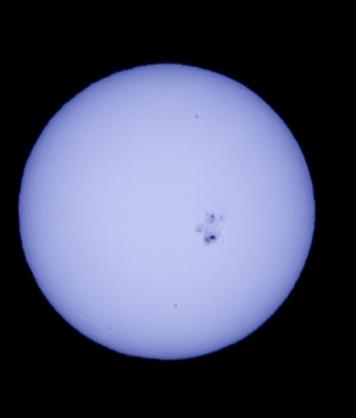
NavList:
A Community Devoted to the Preservation and Practice of Celestial Navigation and Other Methods of Traditional Wayfinding
From: Greg Rudzinski
Date: 2014 Oct 24, 08:06 -0700
Francis,
A 200mm fixed prime lens on a 10 MP digital camera was used for the partial eclipse images. This lens has been previously calibrated for infinite focus so that each pixel = .0975'. The number of pixels from the observed Sun limb to the Moon limb shadow is 179 pixels. 179 x .0975' = 17.45'. An image taken of the Sun before the eclipse is attached and can be used to calibrate given the Sun diameter of 32.15' for the time and date of the image (CalSky web sight).
As for Frank's lunar calculator it is not clear what limb settings to set for a partial eclipse. I went with the setting that gave the more accurate result. The Moon diameter for this partial eclipse is 30.5' geocentric and 30.7' topocentric (CalSky) which is smaller than the Sun's diameter of 32.15'. There is then some asymmetry if calculating distances to nonilluminated or shadowed limbs. Maybe Frank can diagram how his lunar calculator handles the eclipse special case.
Greg Rudzinski
P.S. In a previous post I stated using a 400mm fixed lens which was incorrect. A 200mm lens was used.
From: Francis Upchurch
Date: 2014 Oct 24, 06:18 +0100
Fantastic Greg.
Very jealous, we had nothing in UK . I’m being very dim, but how did you measure the 17.5’ and 35.5’ LDs from the telescope pictures? I’m only just starting to get into astronomy with telescope and want to start taking pictures of lunar eclipses and Jupiter moons for longitude.
Re Newton’s era. The Greenwich Museums have produced a great book “Finding Longitude” (available cheaper from Amazon, beautifully illustrated and full of interesting history on lunars) to go with the current longitude exhibition. Page39 states that In 1713, Newton reported to Parliament that Jupiter’s moons , using latest Casini and Flamsteed tables gave accurate longitude on land, but that lunar theory (his! Gave him a headache!) was still not good enough to give longitude from eclipses better than 2-3 degrees. Page 28 however describes a fairly accurate longitude of Charlton Island, Canada, from lunar eclipse recorded by Welsh explorer Thomas James in 1631.(later compared to London observations to give the longitude). I’m not sure when predictions of lunar eclipses became accurate enough for 1 degree accuracy, presumably before Mayer’s accurate tables for LDs in the mid 1700s? But France had been re-mapped (and shrunk!) using Jupiter moon/Casini based longitudes by 1700.
Fascinating stuff!
Francis Upchurch







